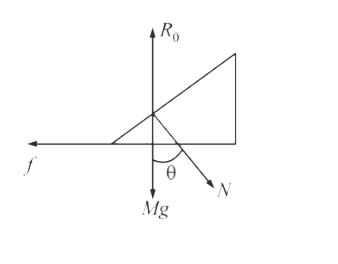The relationship between enthalpy and internal energy change is
mtanθM+m
mcosθM+m
mtanθM+msinθ∞cosθ
msinθM+mcos2θ
The correct Answer is:a
Friction acts on the incline to balance the horizontal component of Balancing forces on incline,
R0=Mg+Ncosθ→R0=(M+m)g
Nsinθf→f=Nsinθmgtanθ
Now put f=μR0 to get
μ=mtanθM+m
This is the minimum value of μ

Topper's Solved these Questions
- INTRODUCTION TO VECTORS & FORCES BOOK - VMC MODULES ENGLISHCHAPTER - INTRODUCTION TO VECTORS & FORCES EXERCISE - JEE Main ( ARCHIVE ) ( LEVEL-1)
12 Videos
- INTRODUCTION TO VECTORS & FORCES BOOK - VMC MODULES ENGLISHCHAPTER - INTRODUCTION TO VECTORS & FORCES EXERCISE - JEE Advanced ( ARCHIVE LEVEL-2)
12 Videos
- INTRODUCTION TO VECTORS & FORCES BOOK - VMC MODULES ENGLISHCHAPTER - INTRODUCTION TO VECTORS & FORCES EXERCISE - level 1
75 Videos
- GRAVITATIONBOOK - VMC MODULES ENGLISHCHAPTER - GRAVITATIONEXERCISE - JEE Advance (Archive) TRUE/FALSE
1 Videos
- JEE MAIN - 5BOOK - VMC MODULES ENGLISHCHAPTER - JEE MAIN - 5EXERCISE - PART I : PHYSICS (SECTION - 2)
5 Videos
Similar Questions
The enthalpy change for chemical reaction is denoted as ΔHΘ and ΔHΘ=HΘP−HΘR. The relation between enthalpy and internal energy is expressed by equation:
ΔH=ΔU+ΔnRT
where ΔU= change in internal energy Δn= change in number of moles, R= gas constant.
Enthalpy of the system is given as
View SolutionThe enthalpy change for chemical reaction is denoted aas ΔHΘ and ΔHΘ=HΘP−HΘR. The relation between enthalpy and internal energy is expressed by equation:
ΔH=ΔU+ΔnRT
where ΔU= change in internal energy Δn= change in number of moles, R= gas constant.
Which of the following equations corresponds to the definition of enthalpy of formation at 298K?
View Solution
Knowledge Check
The relationship between kinetic energy (K) and potential energy (U) of electron moving in a orbit around the nucleus is
AU=−KBU=−2KCU=−3KDU=−12K
The enthalpy change for chemical reaction is denoted aas ΔHΘ and ΔHΘ=HΘP−HΘR. The relation between enthalpy and internal energy is expressed by equation:
ΔH=ΔU+ΔnRT
where ΔU= change in internal enegry Δn= change in number of moles, R= gas constant.
H2(g)+(12)O2(g)=H2O(l),ΔH298K=−68.00kcal
Heat of voporisation of water at 1 atm and 25∘C is 10.00kcal. The standard heat of formation (in kcal) of 1 mole vapour a 25∘C is
View SolutionThe enthalpy change for chemical reaction is denoted aas ΔHΘ and ΔHΘ=HΘP−HΘR. The relation between enthalpy and internal enegry is expressed by equation:
ΔH=ΔU+ΔnRT
where ΔU= change in internal enegry Δn= change in number of moles, R= gas constant.
Enthalpy of the system is given as
View SolutionThe enthalpy change for chemical reaction is denoted as ΔHΘ and ΔHΘ=HΘP−HΘR. The relation between enthalpy and internal enegry is expressed by equation:
ΔH=ΔU+ΔnRT
where ΔU= change in internal enegry Δn= change in number of moles, R= gas constant.
For the change, Cdiamond→Cgraphite,ΔH=−1.89kJ, if 6g of diamond and 6g of graphite are seperately burnt to yield CO2 the heat liberated in first case is
View SolutionThe enthalpy change for chemical reaction is denoted aas ΔHΘ and ΔHΘ=HΘP−HΘR. The relation between enthalpy and internal enegry is expressed by equation:
ΔH=ΔU+ΔnRT
where ΔU= change in internal enegry Δn= change in number of moles, R= gas constant.
For a reaction, 2X(s)+2Y(s)→2C(l)+D(g),ΔH at 27∘C is −28kcalmol−1.ΔU is .....kcalmol−1
View SolutionEnthalpy change equal internal energy change when
View SolutionFor the reaction PCl5(g)→PCl3(g)+Cl2(g) where ΔH and ΔE represents enthalpy change and internal energy change respectively.
View SolutionThe relationship between the free energy change (ΔG) and entropy change (ΔS) at constant temperature (T) si
View Solution
